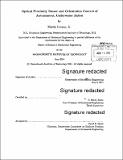Optical proximity sensor and orientation control of autonomous, underwater robot
Author(s)
Lozano, Martin, Jr
DownloadFull printable version (9.956Mb)
Other Contributors
Massachusetts Institute of Technology. Department of Mechanical Engineering.
Advisor
H. Harry Asada.
Terms of use
Metadata
Show full item recordAbstract
Autonomous mobile robots need a reliable means of navigation to reach their target while avoiding collisions. This requires continuous knowledge of the vehicle's position, orientation, and motion as well as a way to identify their surroundings. Exploratory robots and those traveling in complex environments may have difficulty determining their global location. They often rely on data from sensors to estimate their position. While various proximity sensors have been developed for land vehicles, options for underwater vehicles are limited. We detail the design of an optical orientation sensor for fine positioning of highly maneuverable underwater robots. The sensor consists of a camera-laser system (CLS) to geometrically estimate distances to points on a surface. By aggregating and analyzing several data points from multiple lasers, an estimate of the robot's distance, yaw, and pitch are determined. A prototype sensor is constructed and shown to achieve highly accurate distance estimates ( 1mm) at close ranges within 270mm and yaw rotation estimates of 2* within the range of 30*. We also show the successful integration of a gyro with the CLS on an autonomous surface vehicle. The fused estimate of the two sensors results in improved dynamic performance than either sensor alone. The optical sensor corrects the unbounded position error of the gyro measurements with the added benefit of external feedback to avoid collisions in dynamic environments. The gyro provides high frequency orientation estimation in between optical measurements, greatly reduces transient behavior, and generally smoothens vehicle motion. Using this sensor, an underwater robot exploring a complex environment can estimate its orientation relative to a surface in real-time, allowing the robot to avoid collisions with the sensitive environment or maintain a desired orientation while autonomously tracking objects of interest.
Description
Thesis: S.M., Massachusetts Institute of Technology, Department of Mechanical Engineering, 2014. Cataloged from PDF version of thesis. Includes bibliographical references (pages 89-92).
Date issued
2014Department
Massachusetts Institute of Technology. Department of Mechanical EngineeringPublisher
Massachusetts Institute of Technology
Keywords
Mechanical Engineering.